Drinking Water Protection
- Drinking Water Protection Home
- About Us
- A-Z Index of Contaminants in Water
- Community Public Water Supply
- Drinking Water Grants and Loans
- Drinking Water Institute
- Drinking Water in Schools and Child Cares
- Drinking Water Revolving Fund
- Laws and Rules
- Noncommunity Public Water Supply
- Source Water Protection
- Water Operator and Certification Training
- Drinking Water Protection Contacts
Related Topics
- Annual Reports
- Drinking Water Risk Communication Toolkit
- Drinking Water Protection External Resources
- Fact Sheets
- Forms
- Invisible Heroes Videos: Minnesota's Drinking Water Providers
- Noncom Notes Newsletter
- Sample Collection Procedures (videos, pictures, written instructions)
- Waterline Newsletter
Related Sites
- 10 States Standards
- Clean Water Fund
- Health Risk Assessment – Guidance Values and Standards for Water
- Minnesota Well Index
- Water and Health
- Wells and Borings
Environmental Health Division
Hennepin History Museum Celebrates 1983 Circle of Water Circus Tour
From the Fall 2024 Waterline
Quarterly Newsletter of the Minnesota Department of Health Public Water Supply Unit, Waterline
A complete list of feature stories can be found on the Waterline webpage.
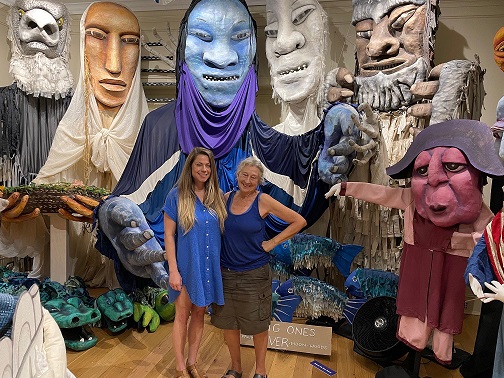
Alyssa Thiede and Sandy Spieler in front of the puppets in the Circle of Water exhibit at the Hennepin History Museum.
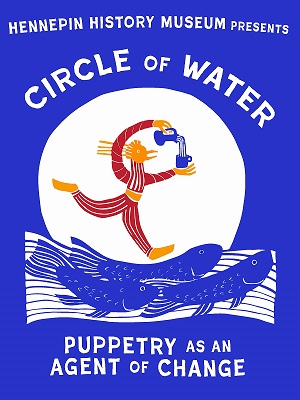 The Hennepin History Museum has opened an exhibit, Circle of Water: Puppetry as an Agent of Change, that will run through June 2026. The exhibit celebrates the four-month Circle of Water Circus in 1983, which was created by the In the Heart of the Beast (HOBT) Puppet and Mask Theatre of Minneapolis.
The Hennepin History Museum has opened an exhibit, Circle of Water: Puppetry as an Agent of Change, that will run through June 2026. The exhibit celebrates the four-month Circle of Water Circus in 1983, which was created by the In the Heart of the Beast (HOBT) Puppet and Mask Theatre of Minneapolis.
HOBT was founded in 1973 as the Powderhorn Puppet Theatre and operated out of the basement of the Walker Community Church in south Minneapolis. In 1979 the theatre changed its name to “In the Heart of the Beast Puppet and Mask Theatre,” moving into the Gustavus Adolphus building on Lake Street and finally into the nearby Avalon Theatre in 1988. Once a family-oriented movie house, the Avalon eventually switched to adult movies. When HOBT moved into the Avalon, it marked the transition on its marquee with “Bye Bye Porn, Hello Puppets.”
Circle of Water Circus
By this time HOBT was focusing on water issues. It put on a variety of shows, including a trip down the Mississippi River, which was a long-time ambition of one of the theater’s founders, Sandy Spieler. Stopping in river cities of all sizes, the troupe of 25 adults, 5 children, and 2 dogs put on a Big Ring Show, side shows, and half- and full-day artist residencies depending on the length of their stay. The main attraction was a performance featuring 150 puppets and original music that “explored the devastation of colonialism throughout the history of the region with an optimistic look towards the future,” according to the museum.
“We tried to be in the town as long as they could host us, and we tried to do workshops with the local people to really consider their connection to the river because a big thing that we were trying to do is just get the people to turn their faces to the water again, which had become a sewage line,” recalled Spieler. “The more that we could be with the local people, the better.”
The tour did its Big Ring Show in 21 cities, and the troupe performed before audiences of several hundred to 4,000, the latter during a two-week stay in St. Louis with performances beneath the Gateway Arch in St. Louis and artist residencies in a number of neighborhoods. “Coming into St. Louis, they brought us in on a tugboat so that they could do a media event,” said Spieler. “They liked it [the circus] so much we were able to do not just one residency, but there were probably five different residencies.
“Our team was split up in different neighborhoods, and then they liked it so much as a community organizing thing that where people could then come together for an event that they continued for a couple years afterwards.”
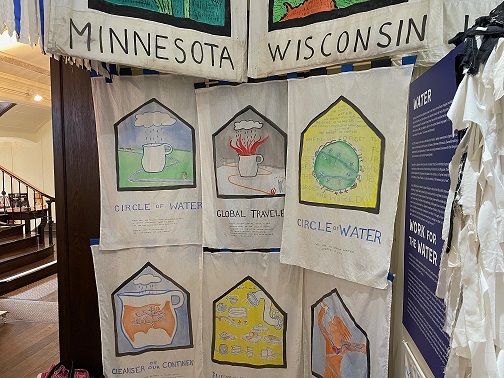
Banners were made for each of the states along the river route.
While a tugboat was used as part of a media event in St. Louis, most of the group traveled by bus, although some came via a small houseboat. “We called it the Collapso [a play on Jacque Cousteau’s Calypso] because it just kept breaking down,” Spieler said. “And that was the same summer that Jacques Cousteau’s men were on the Mississippi River. We kept intersecting with them in different places. And there they were with their big fancy boat, and there we were with our little houseboat. We enjoyed meeting them. They were, of course, intriguing French men. “
The troupe stayed in churches, mansions, college dormitories, and camp sites. Kevin Kling, who became a noted storyteller and commentator on National Public Radio, was a member of the troupe with the artistic skills to make some of the puppets. “He’s actually a pretty fine sculptor,” noted Spieler.
As for funding of the tour, “It wasn’t,” said Spieler. “No one could envision what we were talking about. It’s the problem the puppet theater has always had. It’s not pure visual art. It’s not pure theater. It’s a wild mix of art and theater and ecological education and advocacy.”
The Exhibit
Hennepin History Museum curator Alyssa Thiede said they first accepted a donation of some of HOBT’s puppets during a time when it was uncertain whether the theater was going to be staying at the Avalon. “That’s when Sandy and then-board chair Laura Wilhelm were trying to find a home. Back in 2021 is when they came to us. Have you heard of Sandy’s Puppet Nest?” The “nest” is Spieler’s garage and an adjacent structure she built as a means of saving the puppets.
The donation led to the exhibit about the circus that, noted by the museum, “fostered community, and raised awareness of the ecological distress of the river through the ancient tradition of puppetry.”
Water Initiatives at Hennepin History Museum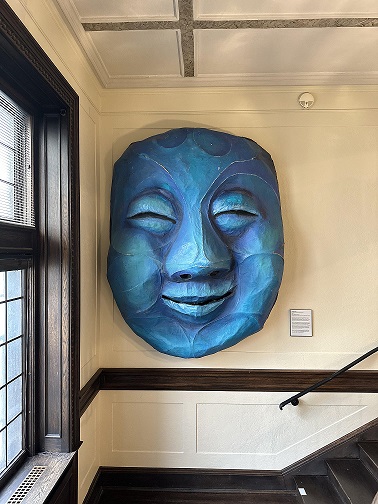 The Circle of Water exhibit is just one of the water initiatives the museum is engaged in. “The unceasing rains and floods of June have put water at the forefront of everyone’s attention,” says a museum press release. “Under the watchful eye of our beloved Water Mask [another gift from HOBT, which was made for one of its Mayday Festivals, pictured at right], recently installed in a place of honor in our Great Stairwell, our efforts to reach out to others and tell different stories has organically coalesced around the importance of water.”
The Circle of Water exhibit is just one of the water initiatives the museum is engaged in. “The unceasing rains and floods of June have put water at the forefront of everyone’s attention,” says a museum press release. “Under the watchful eye of our beloved Water Mask [another gift from HOBT, which was made for one of its Mayday Festivals, pictured at right], recently installed in a place of honor in our Great Stairwell, our efforts to reach out to others and tell different stories has organically coalesced around the importance of water.”
Executive director John Crippen explained some of the museum’s current activities, including the Great Swamp/Skunk Hollow Walking Tours, coordinated in partnership with the St. Louis Park Historical Society. The tour series highlights the often-complicated relationship between people and nature and how decisions made in one era have consequences for succeeding generations. A related exhibit about the tours is now on display at the St. Louis Park Library and may be installed at other locations in St. Louis Park in the months ahead.
Another is the Ĥaĥá Wakapádaŋ/Bassett Creek Oral History Project, which recently won a Minnesota History award. Started as an oral-history project by Valley Community Church in Golden Valley, the project encompasses the lived experiences of indigenous people in the Twin Cities suburbs. “Everyone knows about Native Americans on reservations and urban areas,” said Crippen. “This focuses on Indians in suburbia and the native approach of water quality. Native Americans view water as a relative, asking ‘How are we living in harmony of our relatives?’”
Crippen said it wasn’t their primary intention to dwell on water, but a “nice confluence of events” made it happen,” describing it as “a piece of serendipity that they came together at the same time.”
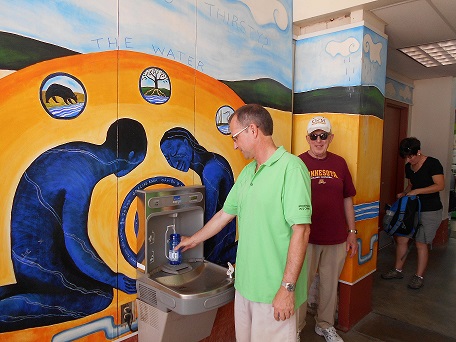
In 2009, the Minnesota Department of Health and Minnesota Section of American Water Works Association commissioned HOBT to make a water mural that wraps around a bottle filling station in the EcoExperience Building at the Minnesota State Fair. The mural is still on display.
Of interest
Minneapolis Theatre Focuses on Water in Series of Performances